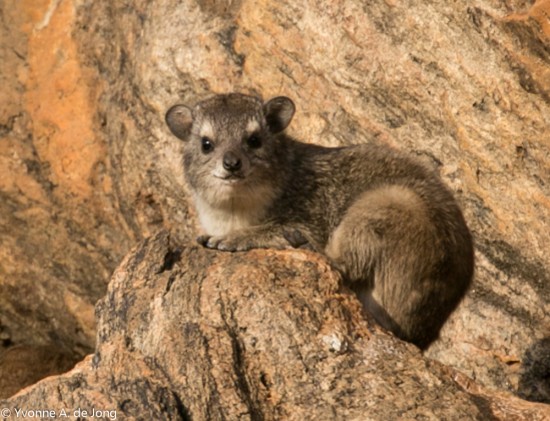Laikipia County, Geography, Environment, and Biodiversity
Author(s): Butynski, T.M. & De Jong, Y.A.
Date: 2015
Registered: Unpublished Report
Author(s): Butynski, T.M. & De Jong, Y.A.
Date: 2015
Registered: Unpublished Report

Each species of hyrax (family Procaviidae) has its own unique set of vocalizations. Their advertisement calls are particularly loud and useful in distinguishing species. During our primate surveys in Eastern Africa, we recorded four species of hyrax, belonging to three genera. These are the southern tree hyrax (Dendrohyrax arboreus), the eastern tree hyrax (Dendrohyrax validus), the bush hyrax (Heterohyrax brucei), and the rock hyrax (Procavia capensis). In the near future, we will present the vocal profiles of these four species of hyrax on this website—similar to our vocal profiles of the Galagos. Until that time, we will, gradually, add our hyrax recordings to this page.

Bush hyrax (Heterohyrax brucei) at Lolldaiga Hills Ranch, Laikipia, Kenya.
Click here to view our Hyrax PhotoMap!
Continue Reading No Comments
There are two species of warthog in Africa, the common warthog (Phacochoerus africanus) and the desert warthog (Phacochoerus aethiopicus). The common warthog is widespread in sub-saharan Africa, including the Horn of Africa (i.e., Kenya, Somalia, Ethiopia, Djibouti, Eritrea). The desert warthog, one of Africa’s least known large mammals, is restricted to the Horn of Africa. Its distribution is, however, poorly understood. Until recently, observers in the Horn of Africa have not differentiated between the two species of warthog. As such, the limits of the distributions of these two species over the Horn of Africa remains poorly known, as does their conservation status.

Adult male desert warthog Phacochoerus aethiopicus in Tsavo West National Park, southeast Kenya. Note the flipped-back ear tips, hooked warts, broad, egg-shaped head, relatively broad snout-disc, and swollen suborbital area (area under the eyes). Photograph by Y. A. de Jong & T. M. Butynski.

Adult male common warthog Phacochoerus africanus on the Laikipia Plateau, central Kenya. Note the cone shaped warts, pointed ear tips, relatively narrow snout-disc, and the diabolo-shaped head. Photograph by T. M. Butynski & Y. A. de Jong.
To better understand the distribution of Africa’s warthogs, we would like to know if you have seen desert warthogs or common warthogs in Eritrea, Ethiopia, Djibouti, Somalia, Uganda, Kenya or Tanzania. A photograph and details of your encounter (including date, coordinates, altitude…or detailed locality description) would be highly appreciated.
Please email your photographs and the details of your encounter, or post them in the ‘comments’ below. Thank you very much!
Yvonne de Jong, Thomas Butynski & Jean-Pierre d’Huart
For more information about the two species of warthog, including their diagnostic characters, see the following publications and websites
De Jong, Y.A. & Butynski, T.M. (2012-2015) Quest for Kenya´s Desert Warthog
De Jong, Y.A. & Butynski, T.M. (2014) Distribution, Abundance, Ecology, and Conservation Status of the Desert Warthog (Phacochoerus aethiopicus) in Northern Kenya.
Culverwell, J., Feely, J., Bell-Cross, S., De Jong, Y.A. & Butynski, T. M. (2008). A new pig for Tsavo.
De Jong, Y.A. Culverwell, J. & Butynski T.M. (2009). Desert warthog Phacochoerus aethiopicus found in Tsavo East National Park and Tsavo West National Park, southern Kenya
d’Huart, J.P. & Grubb, P. (2005). A photographic guide to the differences between the Common Warthog (Phacochoerus africanus) and the Desert Warthog (Ph. aethiopicus).
Continue Reading No Comments

By Yvonne de Jong & Tom Butynski Posted on the National Geographic Explorers Journal on July 8, 2015
Baboons (genus name: Papio; Kiswahili: nyani) are the most widespread of Africa’s monkeys. Occupying most of Africa south of the Sahara, baboons inhabit almost all types of vegetation. It is not difficult to find baboons on the beach of East Africa, in the Fynebos of South Africa, in semi-arid northern Kenya (see our earlier post: “Finding a New Monkey for East Africa”), in bamboo forest in Senegal, or in montane forest in Tanzania and Uganda.
Continue Reading No Comments
By T.M. Butynski & Y.A. de Jong, Primate Conservation 29
Abstract: The Mount Kilimanjaro guereza Colobus guereza caudatus is considered to be endemic to northeast Tanzania. This paper presents the first records for C. g. caudatus in Kenya, describes the distribution of this subspecies, and assesses its conservation status.
Continue Reading No Comments